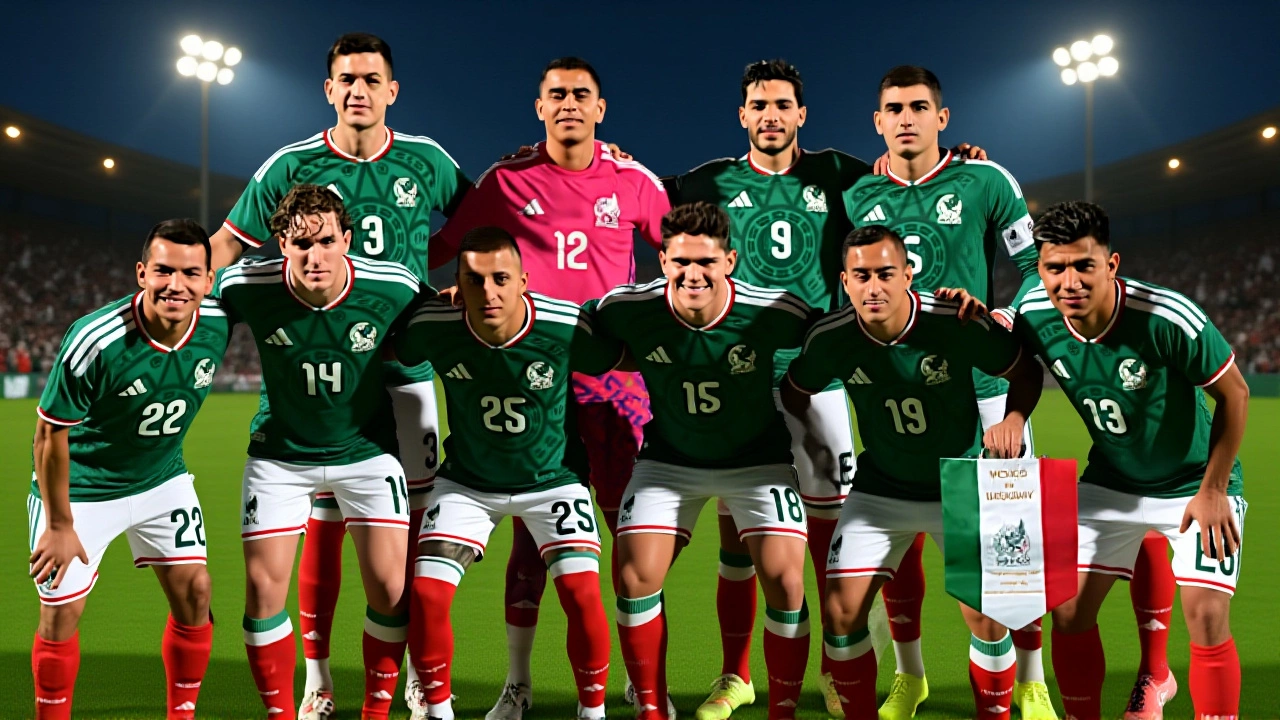Mexico and Uruguay Fight to 0-0 Draw Amid Controversial Penalty Calls in Torreón Friendly
 Nov, 16 2025
Nov, 16 2025
On a humid November evening in Torreón, Mexico, two proud footballing nations clashed in a match that delivered more heat than goals. Mexico vs. Uruguay Estadio Corona ended 0-0 — but the real story wasn’t on the scoreboard. It was in the tackles, the shouts, the VAR reviews, and the unanswered questions left hanging in the air after the final whistle at 90'+5'.
Physicality Over Precision
The match, billed as a preparation fixture for both teams ahead of future competitive campaigns, was anything but pretty. With Mexico and Uruguay trading hard challenges and minimal attacking flair, fans in the stands were left watching more fouls than finishes. According to Rafael Hernandez of FMF State of Mind, the game had “few exciting moments throughout,” a sentiment echoed by viewers across Latin America. No player managed to break the deadlock despite 15 documented chances — most of them blocked, deflected, or saved.The defining moment came in stoppage time. Johan Vásquez, Mexico’s central midfielder, rose to meet a cross from Gilberto Mora, directing a powerful header toward goal. Santiago Mele, Uruguay’s goalkeeper, reacted with instinctive brilliance, palming it away. But the real drama wasn’t the save — it was what happened just before. Replays showed César Montes, Mexico’s captain, tumbling inside the box after a slight shoulder nudge from Jorge Giménez, Uruguay’s defensive anchor. Was it a penalty? The referee said no. The VAR team reviewed it. They didn’t overturn it. Fans in Torreón booed. Fans in Montevideo shrugged.
The Refereeing Controversy
The officiating crew — led by referee Fernando Javier Moron Valdelamar, with VAR official Jesús Montero — faced immediate scrutiny. A YouTube analysis from Fox Deportes, titled “WAS A PENALTY OR NOT?”, captured commentators Keith and Mariano debating the incident at the 62-minute mark. “It’s clear. There’s contact inside the box,” Mariano insisted. “It’s slight,” countered Keith. “They’re going to have to be separated.” The broadcast also referenced a mysterious figure named Aguirre — possibly a coach or analyst — saying, “They need to come down.” No coach by that name appeared on either team’s official roster, leaving viewers to wonder if it was a misheard name or an uncredited advisor.Adding to the confusion, Sky Sports labeled the match “Full Time After Extra Time,” despite no extra time being played. Meanwhile, Flashscore.com listed the game as occurring on November 16 — a discrepancy likely due to time zone differences between European servers and the local PST start time. These inconsistencies, minor as they seem, eroded trust in the reporting infrastructure around what should’ve been a straightforward friendly.

Lineups, Substitutions, and Tactical Shifts
Mexico started with a familiar core: César Montes (captain, #3), Eduardo Álvarez (#4), and Raúl Jiménez (#9) leading the line. But the team struggled to create fluidity in the final third. Substitutions came thick and fast — Hirving Lozano was replaced at halftime, Eduardo Sánchez and Miguel Ruiz swapped out at 65’, and Montes himself came off in the 89th minute. The final XI looked more like a tactical experiment than a cohesive unit.Uruguay, meanwhile, relied on grit. Captain Jorge Giménez (#2) played the full 90 minutes before being subbed off in the 84th — a rare move for a defensive stalwart. His presence anchored a backline that weathered Mexico’s few attacks. Santiago Mele (#23) was Uruguay’s unsung hero, making four key saves, including the decisive stoppage-time denial. His calm under pressure mirrored Uruguay’s philosophy: defend first, attack second — if at all.
What This Means for Both Teams
For Mexico, the draw exposed lingering issues. Their defense was organized — no goals conceded, no major breakdowns. But their attack? Still too reliant on individual brilliance. “The final product, the final 30 — it has improved,” noted Fox Deportes’ analysts. Yet, without a clinical finisher or a creative spark, they remain vulnerable against top-tier opponents.For Uruguay, the match was a textbook example of their identity. They didn’t need to dominate. They just needed to survive. With the 2026 World Cup looming, this was less about style and more about resilience. Giménez’s leadership, Mele’s composure, and the midfield’s discipline suggest they’re building toward something dangerous — even if it’s not pretty.
Meanwhile, the broader November 2025 international window offered context. While Mexico and Uruguay battled in Torreón, the USMNT beat Paraguay 2-0 in Chester, Pennsylvania, with Giovanni Reyna and Folarin Balogun finding the net. That result underscored the growing gap in attacking quality between North and South American teams — a gap Mexico continues to struggle to close.

What’s Next?
Both teams will now turn their focus to competitive qualifiers. Mexico faces Costa Rica in March 2026, while Uruguay meets Colombia in the same window. The 0-0 draw in Torreón won’t be remembered for its goals — but it might be remembered for the questions it raised. Was that a penalty? Why did the officials hesitate? And why, after all these years, does Mexico still struggle to turn pressure into points?The answer may lie not in tactics, but in mentality. In football, as in life, sometimes the hardest thing to fix isn’t the technique — it’s the belief.
Frequently Asked Questions
Was the penalty call in the 62nd minute actually missed?
Multiple replays show clear, albeit minimal, contact between César Montes and Jorge Giménez inside the penalty area. While not a violent or obvious foul, FIFA’s 2025 guidelines state that any contact that impedes a player’s momentum during a scoring opportunity should be reviewed. The VAR team chose not to intervene, citing “insufficient evidence of clear error,” but the decision remains controversial among analysts and fans.
Why did Sky Sports say the match went to extra time?
This was an error in Sky Sports’ automated data feed. Friendly matches do not include extra time unless specified — and this one wasn’t. The system likely misread the 90'+5' stoppage time as “extra time” due to a glitch in their match clock parser. Flashscore.com’s date discrepancy (Nov 16 vs. Nov 15) further suggests regional server synchronization issues.
Who is Aguirre, and why was he mentioned in the broadcast?
No coach named Aguirre was listed on either team’s official match sheet. The name likely refers to a former Mexico coach, Gerardo Martino’s assistant or perhaps a pundit misheard by commentators. It’s possible the name was incorrectly transcribed during live audio capture — a common issue in high-pressure broadcasts.
How did Mexico’s defense improve compared to previous friendlies?
Mexico conceded zero goals in this match — their first clean sheet in three 2025 friendlies. They held Uruguay to just two shots on target, compared to five in their previous match against Colombia. The midfield trio of Vásquez, Álvarez, and Ruiz provided better cover, and fullbacks stayed narrower. Still, their transition play from defense to attack remains sluggish.
What does this result mean for Mexico’s World Cup chances?
While a clean sheet is encouraging, Mexico’s inability to convert chances — they’ve scored just 2 goals in their last 4 friendlies — raises red flags. To qualify for the 2026 World Cup, they need consistency against top CONCACAF rivals. Without a reliable striker or a creative playmaker, their path to the knockout stage remains uncertain, even as hosts.
Did Uruguay’s performance suggest they’re a threat in 2026?
Absolutely. Uruguay’s 0-0 draw against Mexico — a team with superior individual talent — highlights their tactical discipline and resilience. With Giménez, Mele, and Bentancur all playing 90+ minutes, they showed they can grind out results even without dominance. If they maintain this structure, they’ll be among the most dangerous teams in the tournament’s second round.
